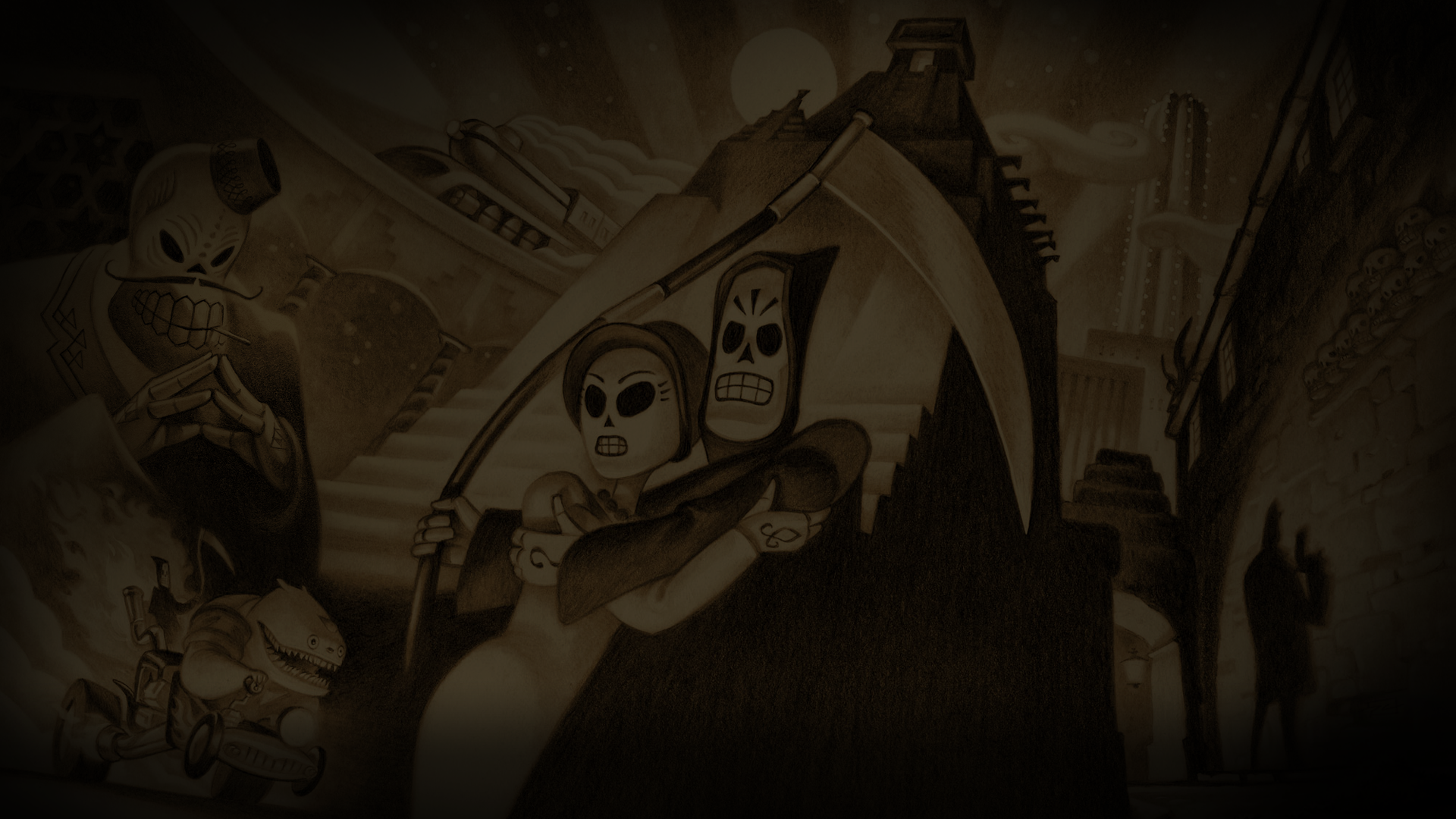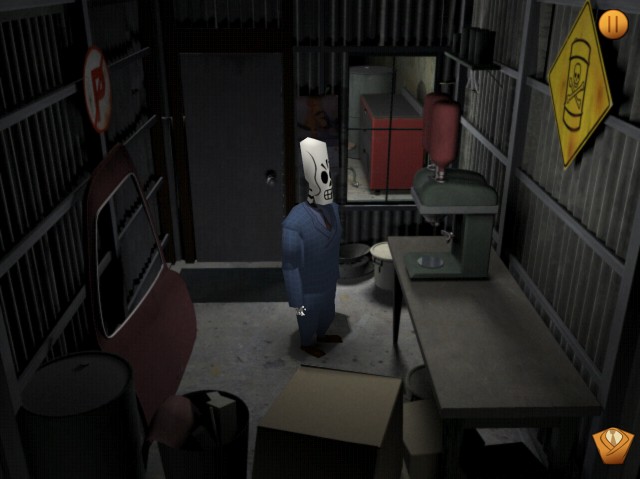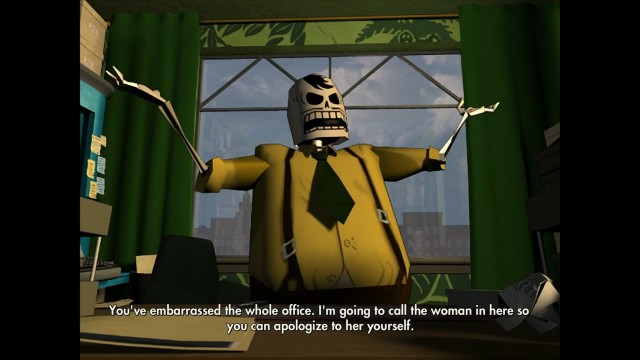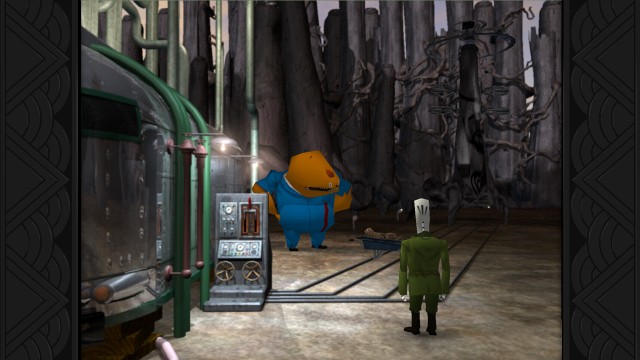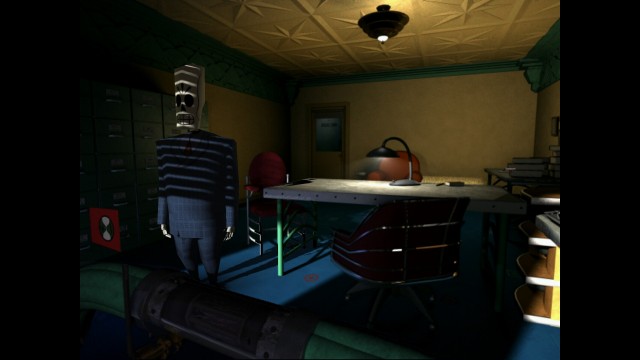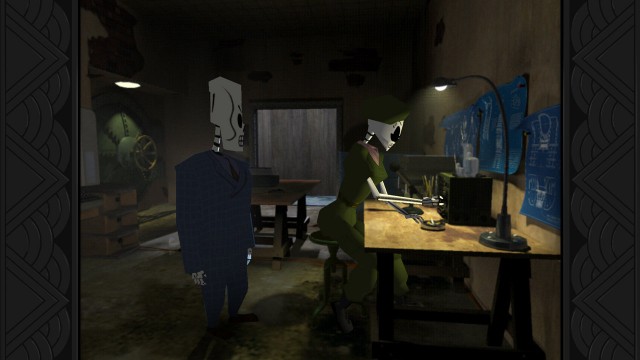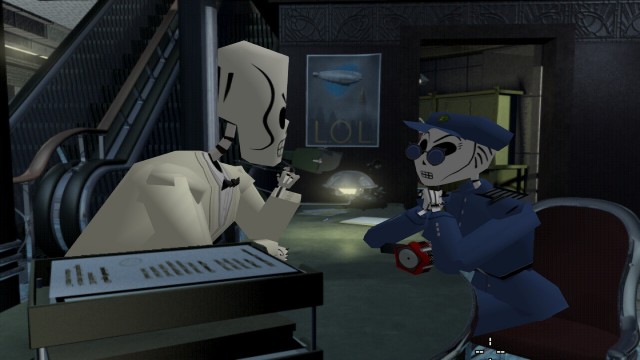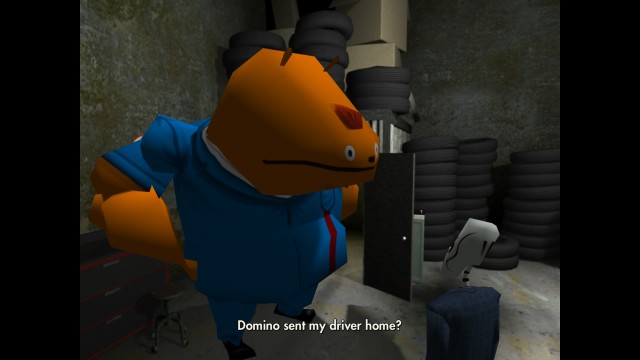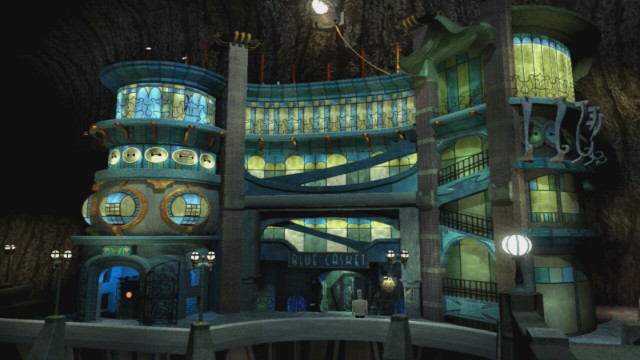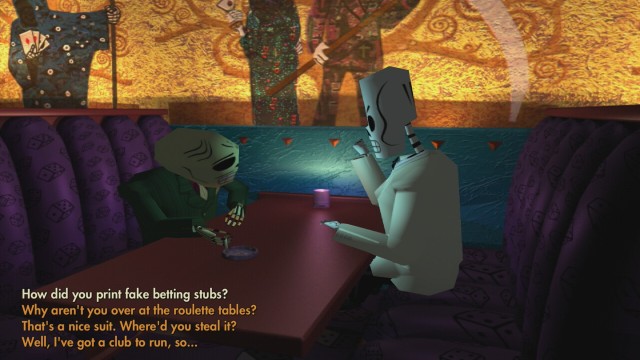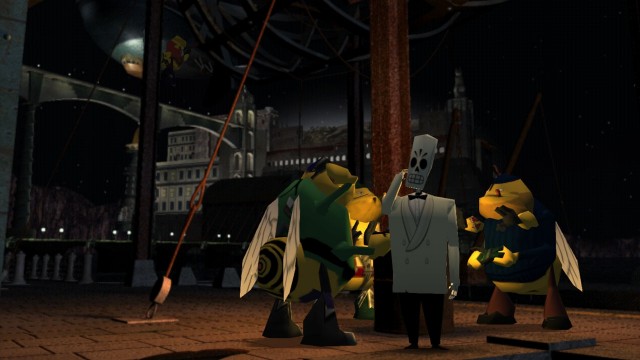UPDATE: While our review primarily focuses on the original PC and PlayStation builds of Grim Fandango: Remastered, we have added an additional section towards the end that addresses the belated iOS and Android ports.
LucasArts’ Grim Fandango is considered to be one of the greatest adventure games of all time, which is why it’s a shame that it became virtually impossible to find shortly after its original release on PC in 1998. Not only did limited runs of the game package prove rare, but the game’s system requirements were also quite picky, so even if you did track a copy down, it would no doubt refuse to run on anything more recent than a Windows 95-powered computer from the 1990’s.
Fortunately, Sony and Tim Schafer have done the gaming industry an incredible kindness. After pooling some funding between the PlayStation maker and Schafer’s Double Fine Productions, Grim Fandango was restored from the grave as Grim Fandango: Remastered, a readily accessible and slightly more polished version of this long-hidden gem, for modern PC storefronts and current PlayStation platforms. Sadly, due to Sony partially funding the game for exclusivity rights, Xbox and Nintendo gamers likely won’t see this remaster any time soon, if at all.
To answer the first and most obvious question, yes, Grim Fandango absolutely holds up today! LucasArts may no longer make games now, but Grim Fandango: Remastered makes a great case for their timeless, witty and thoroughly unique adventure gaming classics that completely deserve more attention from the modern wave of gamers. It’s a bit unfortunate that only PC gamers and PlayStation gamers will get to experience the game’s new lease on life, but that’s certainly better than just allowing Grim Fandango to be lost in the ether of inaccessible cult hits.
If you’ve never played Grim Fandango before, then Grim Fandango: Remastered is a mandatory download on whichever platform you can get it for, as it’s required playing for any serious gamer with a passion for the medium. Even if you’ve already played through the original 1998 build of the game several times, the remaster is well worth your attention, thanks to a cross-buy offer between its PS4 and PS Vita versions, and even its PC, Mac and Linux versions having some appreciated touch-ups, namely a new mouse-controlled interface.
Great revivals of great games deserve to be celebrated, and Grim Fandango: Remastered is both highly reverent of the original 1998 PC build, while touching up what’s necessary to give it an extra appealing shine.
Grim Fandango: Remastered makes a handful of touch-ups to the original 1998 graphics, smoothing out the jagged pixels in the character models, and adding improved lighting effects that give the environments more immersion. Even without these small refinements, the game’s highly-defined, Day of the Dead-esque aesthetics have held up remarkably well, and need few upgrades to feel like they fit right in with modern visual design.
Of course, there are a lot of untouched visual elements from 1998 that stick out a little more in some spots as well. The fixed camera angles that abruptly jump views as you move can sometimes be a nuisance when trying to navigate environments for example, and while most characters look great, some more abstract characters such as your demon buddy, Glottis still look like a primitive blob of polygons. Similarly, the original 1998 FMV cutscenes appear to be untouched in the remaster, awkwardly sticking out with their grainy pixels and stiff animations amidst the refined, HD-revamped touch-up given to the in-game models and fixed environments.
The PC/Mac/Linux version of the game looks and runs pretty well indistinguishably from Grim Fandango’s new console build on the PS4, with all of these versions presenting the same sharp retro-chic graphics, and only occasionally dated-looking visual design. The PS Vita version also stands pretty effortlessly with its PC and console counterparts in terms of graphics, albeit with predictably decreased resolution. The PS Vita version also has noticeably longer load times than the PS4 and PC versions, which are especially annoying when trying to save and load your game. The sequences with heavily zoomed-out camera angles are at their worst on PS Vita as well, with your character barely being a pixel tall on the PS Vita screen in those places, and already being hard enough to spot with the larger screens you have to work with on PS4 and PC.
Perhaps the biggest disappointment with the graphics however is that the original 4:3 aspect ratio from the 1998 build has been left untouched in the remaster, leaving grey bars on both sides of the screen on any platform. There is an option to force a stretched 16:9 ratio, but it’s not worth it. It gets rid of the bars, but it looks awful. It’s no doubt that Double Fine presented the original 4:3 aspect ratio by default because they knew that their efforts to stretch the game to 16:9 for modern screens just didn’t work.
Still, even considering that the visual template of 1998 has largely been left alone, beyond some tweaks to smoothness and lighting, Grim Fandango: Remastered is very appealing to look at, thanks to its colourful, kooky charm throughout the visual design. The fixed environmental backdrops still feel strangely immersive today, and while some models couldn’t be salvaged from their primitive 1990’s polygons, they’re at least made to look a bit sharper in the remaster. You’ll sometimes be reminded that Grim Fandango: Remastered is a game from the 1990’s, but you’ll still have no effort falling in love with its world, even with the sophisticated gaming technology of 2015.
Grim Fandango’s audio elements didn’t seem to receive any touch-ups at all in the remaster, which sports the same effects and voice work as the original 1998 release, with perhaps a bit of added sound definition to accommodate modern sound systems. The game’s music tracks have also been touched up with orchestral revamps. Even the perfectly preserved elements are just fine however, since the original audio work in Grim Fandango was already pretty well flawless in 1998.
The game’s soundtrack sports tons of character, juggling genres between soft blues, jazz, environmental ambience, cartoon crescendos, and other such genres that help to give the game a sense of darkly amusing melancholy. Similarly, the sound effects still carry lots of cartoon punch, sounding clear and sharp as day across all versions of Grim Fandango: Remastered, particularly if you plug in some headphones. It truly is amazing how well this original audio has held up with pretty much no changes in 2015, beyond the orchestral music.
Standing tallest of all however is the outstanding voice work, which was of unusually amazing quality for the frequently shaky video game voiceover jobs of the era. Again, the voice acting is unchanged in the remaster, but there’s no reason to re-do it. It’s already awesome! Every personality in the game boasts tons of exaggerated character, being instantly memorable for their sly, cheeky or otherwise amusing personalities, and leaping off of the screen with every spoken word of dialogue, lending more surprising credibility to Grim Fandango’s bizarre world.
As much as Grim Fandango was never wanting for compelling style, its audio is perhaps an even bigger showcase of why it stood out so much amongst the other PC adventure games of the late 1990’s!
Grim Fandango: Remastered unfolds over four ‘years’ of the main character’s afterlife. Yes, you are already dead at the start of the game (and as with other LucasArts adventure game classics, there is no fail-state), working as a travel agent named Manny Calavera for the Department of Death, which helps to guide newly dead folks to their rightful place in the afterlife, where souls are either judged, exalted to the heavens, or forced to work off a sentence of years in purgatory. Manny is one such neutral soul, working out his years of service to the Land of the Dead so that he may claim his Number Nine Ticket to his final resting place.
Early in the game however, Manny uncovers a racket at his office, and the entire game is about solving the mystery behind it. You are thus charged with finding objects, interacting with characters of interest, solving puzzles, and doing whatever is necessary to proceed the story.
Since this is an adventure game from 1998 however, bear in mind that you’ll have to put up with some questionably-aged adventure game design from that era, particularly if you’ve gotten your feet wet with modern point-and-click adventure games like those by Telltale, or perhaps properties like Ace Attorney or Zero Escape. Designer moonlogic has been left fully intact in Grim Fandango: Remastered, forcing you to try everything with everything, and hope that you stumble into progress.
It might be prudent to pull up a walkthrough as you play, given that some solutions in the game will take ages to figure out, potentially making an otherwise excellent experience become frustrating. Likewise, this will also minimize the chances that you will end up hopelessly stuck in a situation that you can’t resolve, particularly since the game really doesn’t spoonfeed you at all. When you start, you’re dumped right into proceedings, and left to figure everything out on your own, including how the mechanics work, and how you even control Manny.
On the one hand, this is reverent of typical adventure game design from 1998. You’re dropped in, pants or no, and expected to get by on your own wits, never receiving any help from the game like you would nowadays. On the other hand however, Grim Fandango: Remastered might have benefited from including an optional hint system, especially since some of the puzzles make precious little sense in terms of how you proceed forward. Adventure gaming purists could have ignored it, while newcomers exploring the game for the first time won’t feel like they can’t enjoy the experience because they’re constantly getting stuck if they opt not to use a walkthrough.
Likewise, the game even rightfully warns you that it doesn’t feature autosaves, which are taken for granted in modern games, but were often a pipe dream in 1998. Players should remember to manually save often, and perhaps keep several files in case they end up hopelessly lost, and need to backtrack to an earlier point in the game. This is also helpful for avid achievement/trophy hunters, since almost every achievement/trophy description in the game is hidden until you stumble upon it by screwing around with character dialogue and points of interest. Those who get the game from GOG won’t have achievements to worry about, but Steam users have a roster of Steam Achievements to earn, just as PlayStation gamers can strive for a pretty straightforward Platinum Trophy, if they’re real completionists. In the case of PlayStation, the fact that the Cloud allows you to automatically share your game progress between your PS4 and PS Vita with no manual input is also a nice plus, allowing you to seamlessly resume your game on the go, if you need to leave your console.
There’s something to be respected about the faithfulness to vintage adventure game design, but you have to be ready for it going in. Still, if you can accept the fact that Grim Fandango: Remastered doesn’t add modern concessions, beyond some small new dabbles of paint and achievements/trophies to chase for all but GOG users, you’ll no doubt find that it’s an incredible experience, even today. The story, characters, atmosphere and charm are what really carry the gameplay, despite the fact that some of the puzzle solutions will positively mystify you, even after you’ve solved them.
Fortunately, navigation is one thing that Grim Fandango: Remastered did fix up from the original 1998 release. Back then, you were limited to ‘tank’ controls that had you using the keyboard (or a joystick or gamepad, if you had one) to turn Manny in place with the Left and Right keys, then have him move forward and backward with the Up and Down keys, similar to classic-style Resident Evil games for example. You can still play with these controls (in fact, there’s an achievement/trophy to earn for playing through the entire game that way), but you now have the option of a modern control scheme that allows you to simply move Manny in a desired direction with your arrow keys or controller stick, which is especially appreciated in the PlayStation builds.
Likewise, interacting with objects or character prompts could sometimes be finicky in the original 1998 build, since you had to use the keyboard in most cases, and collision placement was spotty at best. Now, in the modern PC, Mac and Linux versions of the remaster, mouse controls have been added that let you far more easily interact with characters and objects with a simple swipe and click of the mouse, and this control method is long overdue for a game like this. You can use a gamepad if you wish, but playing with a mouse and keyboard feels like the best and most natural way to experience Grim Fandango: Remastered, despite the game’s small mouse hiccup of being unable to process movement and actions at the same time, which oddly necessitate separate clicks.
Obviously, those playing on PlayStation platforms won’t have the option of using a mouse, though the controls still feel comfortable and natural on the PS4’s Dual Shock 4 controller, and the PS Vita’s button scheme. You can use either the Directional Buttons or left analog stick to move Manny, with X interacting or using an item, Square examining something, Circle putting something in Manny’s inventory, and Triangle accessing Manny’s inventory, with R1/R left to be held when the player wishes to run faster. The PS Vita version of Grim Fandango: Remastered even allows you to use the Touch Screen to tap on objects of interest and move Manny, allowing you to switch between buttons and a point-and-click interface on the fly, which is quite handy.
The game’s story should run you about 10-12 hours, potentially longer if you find you’re routinely stumped by more off-the-wall puzzles. There’s plenty of replay value involved in interacting with everything and everyone though, especially when you have the added incentive of chasing achievements/trophies to reward you for being thorough. PlayStation players could snag the Platinum Trophy in one playthrough if they know where every trophy is hidden, but there’s something very rewarding about discovering these little rewards for yourself, particularly when the game’s fun and kooky dialogue is often its own reward.
You also have the option of experiencing Grim Fandango: Remastered with a directors’ commentary in the re-release, which is great for a second playthrough, or if you’ve already played the original 1998 game, and want to learn more about how it came together as you re-experience it. It’s quite the bonus for avid LucasArts enthusiasts, who get lots of cool insight into one of the company’s most beloved under-the-radar hits.
Grim Fandango: Remastered is overall a wonderful return to a simpler time for adventure games. It can also be a throwback to clunkier adventure game mechanics of 1998, namely with its frequent lack of direction and cumbersome inventory system that has you scrolling through everything until you find the item you want, but that’s part of the charm. The easily-frustrated will want a walkthrough handy, but nonetheless, Grim Fandango: Remastered is a gameplay experience meant to be studied and revered as much as it is flat-out enjoyed.
As mentioned, Grim Fandango: Remastered unfolds over a four-year period of the afterlife of Manny Calavera, a travel agent that helps the newly dead get to where they need to go after they’ve passed on. After discovering that his department is corrupt however, Manny joins a resistance movement that aims to expose a racket with grave implications, ahem, for the dear departed.
I can’t say much else without spoilers, but trust me when I claim that Grim Fandango: Remastered’s story is a bona fide delight. Both darkly comedic and genuinely intriguing, Grim Fandango: Remastered creates a brilliant and memorable world, broken into surprising and often hilarious set pieces, each more unexpected than the last. Sure, this contributes to the mystifying element of designer moonlogic in the puzzle-solving, but it also helps the game stand firmly apart from anything else like it, even now.
As the years go by in Manny’s afterlife, you’ll find yourself doing things like managing a club, fleeing a sinking ship, and learning all about what makes afterlife government work. Every set piece is cool and interesting, and every section of the story manages a swell of emotions, with the frequent sense of humour also evoking genuine drama and tragedy in so many excellent narrative segments.
Like I said, the mystery is best left with the player knowing as little about it as possible, but even returning fans who have gone many years without playing the original 1998 build of Grim Fandango will love falling in love with this brilliant plot all over again. It’s one of the finest testaments to LucasArts’ outstanding pedigree as an adventure game storyteller!
Grim Fandango: Remastered has seen a belated expansion to mobile devices, and for the most part, all of the enhancements from the PC and PlayStation builds are present on mobile, minus expected omissions like trophies or Steam Achievements.
The iOS and Android versions are both respectable mobile ports that run well, and boast the same graphical boosts over the original game from PC and PlayStation, along with the orchestral soundtrack and developer commentary. The touch-only controls generally work well to boot, with a specialized contextual menu HUD replacing the button/key inputs from the original releases. The only sticking point on mobile devices is actually moving Manny around, which can be a nuisance, as the game has more trouble than ever recognizing certain inputs on mobile, and the movement has it the worst.
Ultimately, the PS Vita version is still the best way to take Grim Fandango: Remastered on the go, particularly since the game’s graphics do take a slight hit on smartphones most of all, especially since Manny becomes virtually microscopic during far camera views on smartphones. If you don’t own a PS Vita however, and are interested in playing Grim Fandango on the go, the iOS/Android versions of Grim Fandango: Remastered are solid, especially for their slightly discounted price.
You need an appreciation of retro adventure game design to get into Grim Fandango: Remastered, but that’s all you need. This was one of the best original IP’s to come out of LucasArts back in its heyday, and it’s still one of the all-time best classics that the company ever produced, even today. Mystifying puzzles and clunky inventory navigation notwithstanding, Grim Fandango: Remastered often stands effortlessly with modern adventure games, with this gem being just as appealing now as it was back in 1998.
Better still is that both the PC and PlayStation offerings turned out equally well. Those who own PlayStation platforms will find that Grim Fandango fits them like a glove, acclimating to both PS4 and PS Vita with no hassle, particularly since the PS Vita version offers the added benefits of portability and touch controls, at the cost of increased load times. The fact that the game supports cross-buy on PlayStation, netting you both the PS4 and PS Vita versions with a single purchase of either, is all the better. Those without PlayStation devices however will still get a high-quality, effectively refined experience on PC, Mac or Linux, with very modest system requirements that enable the game to work on most any recent computer, and additional mouse controls that wash away the rather clunky navigation of the original 1998 build, unless you want to play like a purist, that is. Either way, you can’t go wrong.
Even almost twenty years after its initial release, Grim Fandango still feels like it’s taking so many other adventure games to school. Its outstanding character, charm, humour and atmosphere are still incredible, and Grim Fandango: Remastered adds whatever polish it needs to, without disturbing the excellent foundation of what was already in place. Some may long for the missing modern concessions that might have made the experience just that much more user-friendly, but that’s missing the forest for the trees.
Bottom line, one of LucasArts’ best and most inaccessible classics is now easy to buy, run and experience, for just $14.99. That alone is cause for celebration. Every other benefit is icing on the cake.

